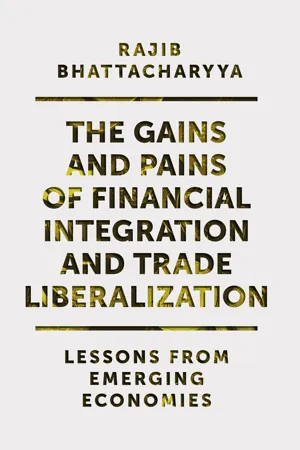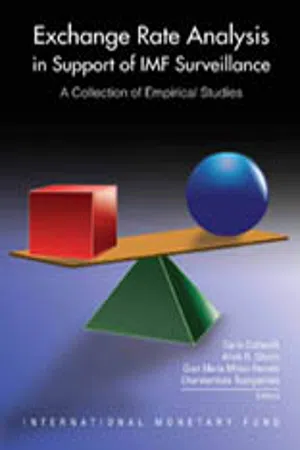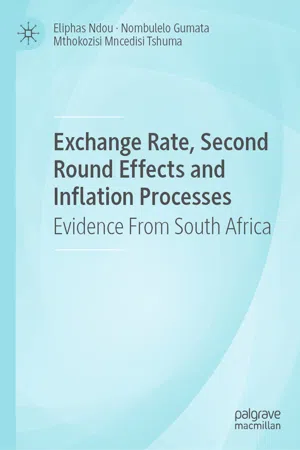Economics
Exchange Rate Pass Through
Exchange Rate Pass Through refers to the extent to which changes in exchange rates affect the prices of imported goods and services. It measures how much of a currency depreciation or appreciation is passed on to consumers in the form of higher or lower prices for imported products. A high pass through means that exchange rate movements have a significant impact on domestic inflation.
Written by Perlego with AI-assistance
Related key terms
Related key terms
1 of 4
Related key terms
1 of 3
5 Key excerpts on "Exchange Rate Pass Through"
- eBook - ePub
The Gains and Pains of Financial Integration and Trade Liberalization
Lessons from Emerging Economies
- Rajib Bhattacharyya, Rajib Bhattacharyya(Authors)
- 2019(Publication Date)
- Emerald Publishing Limited(Publisher)
Finally, a rise in exchange rate feeds into the domestic price level (though imperfectly) and reduces real value of money holding or wealth, reducing consumption (through real balance effect) and hence, aggregate demand. From Fig. 14.1, it is clearly evidenced that there is a co-movement in exchange rate and inflation rate. It alludes to the phenomenon of a long-run stable relation between the two variables, and this is the area of focus of this chapter. Against this backdrop, it has become extremely important to empirically measure the degree of pass-through of exchange rate to domestic prices. The rest of the chapter is arranged as follows. Section 2 provides a brief literature survey. Section 3 elaborates the methodology used to examine the problem at hand and thereafter, derives the results. Finally, we conclude the chapter in Section 4. Literature Survey Different economists have used different frameworks to measure the degree of pass-through. The Bank of Israel uses an open economy version of a New Keynesian Phillips curve relating inflation and exchange rate (Elkayam, 2004). Longworth (2002) too uses a Phillips curve relation to examine the impact of exchange rate movements on consumer prices. While the aforementioned studies estimate pass-through equations with aggregated data, some authors also introspect the degree of pass-through in various sectors like Goldberg and Knetter (1997), Campa and Goldberg (2002), and Bugamelli and Tedeschi (2004). Several papers also estimate pass-through for a panel of countries, like Bailliu and Fuji (2004) and Mohanty and Klau (2001). However, these studies neglect India. Only a few economists concentrate on the Indian economy. Ghosh and Rajan (2007) use a sample that ranges from Q1 1980 to Q2 2005, and using a co-integration approach, find evidence of long-run elasticity of 40% and short-run elasticity of 10%. They also opine that ERPT has risen post liberalization - eBook - ePub
- Charalambos Tsangarides, Carlo Cottarelli, Gian Milesi-Ferretti, and Atish Ghosh(Authors)
- 2008(Publication Date)
- INTERNATIONAL MONETARY FUND(Publisher)
In the presence of local distribution costs, firms may also face offsetting factors when the exchange rate changes, leading to international price discrimination and incomplete pass–through (see Corsetti and Dedola, 2002, and Choudhri, Faruqee, and Hakura, 2002). These factors can help account for the difference in responses between “first–stage” pass–through (for example, in import prices) and “second–stage” pass–through (for example, in consumer prices). Moreover, these considerations have been shown to have important implications for optimal monetary and exchange rate policies (see, for example, Corsetti and Pesenti, 2002, and Devereux and Engel, 2003). This chapter examines exchange rate pass–through and its behavioral determinants in the euro area. The methodology proceeds in two parts. First, the empirical analysis follows a vector autoregression (VAR) approach, in which the time–series behavior of the euro exchange rate and a system of euro area prices are examined. Specifically, the empirical analysis investigates exchange rate pass–through into a set of prices along the pricing chain. Second, the impulse response functions (IRFs) from the VAR estimation are used to calibrate in a new open economy macroeconomics model the key behavioral parameters that can help reproduce the pattern of pass–through and external adjustment in the euro area. The use of a VAR approach to examine exchange rate pass–through has several advantages compared with single–equation methods. Previous studies typically have focused on pass–through into a single price (for example, import or consumer prices) without further distinguishing between the types of underlying exchange rate shocks (for example, permanent or transitory) that may be occurring. By investigating exchange rate pass–through into a set of prices along the pricing chain, the VAR analysis characterizes not only absolute but relative pass–through in upstream and downstream prices - eBook - ePub
Exchange Rate, Second Round Effects and Inflation Processes
Evidence From South Africa
- Eliphas Ndou, Nombulelo Gumata, Mthokozisi Mncedisi Tshuma(Authors)
- 2019(Publication Date)
- Palgrave Macmillan(Publisher)
absence of the ERPT channel .9.1 Introduction
The long period during which the consumer price inflation exceeded 6% between 2016M1 and 2017M3, was accompanied by the declining exchange rate pass-through (ERPT ) to consumer price inflation as shown in Fig. 9.1 a, and an appreciation in the nominal effective exchange rate (NEER) in part (b). In addition, the peak of policy rate tightening cycle in 2016 coincided with a decline in ERPT in Fig. 9.1 c, and an appreciation in the NEER in part (d). These developments point to the need to determine the applicability of the Taylor (2000 ) hypothesis and the relevance of the Gagnon and Ihrig (2004 ) findings in South Africa.Fig. 9.1Trends of ERPT , inflation, exchange rate and the repo rate. Note The NEER is inverted such that an increase (decrease) implies a depreciation (appreciation). The growth refers to annual growth(Source South African Reserve Bank and authors’ calculations)The research studies for instance, Aleem and Lahiani (2014 ) attribute the decline in ERPT to a change in the inflationary environment and the credibility of monetary policy conduct. The Taylor hypothesis suggests that a credible monetary policy which controls inflation will lower the ERPT by reducing the perceived persistence of the shocks affecting the firm’s costs. In addition, the Gagnon and Ihrig (2004 ) findings suggest that the aggression of the monetary policy reaction towards inflation will lead to a slowdown in the ERPT to inflation . Furthermore, Devereux and Yetman (2002 ) postulate that the frequency of price changes depends on monetary policy reaction. A credible monetary policy reduces the frequency of price changes.Hence, it is important for this chapter to investigate whether the monetary policy channel impacts - eBook - ePub
- W. Charles Sawyer, Richard L. Sprinkle(Authors)
- 2020(Publication Date)
- Routledge(Publisher)
1 . However, U.S. import prices have not fallen by as much as the increase in supply. This would only occur if the supply curve were completely horizontal (perfectly elastic). Since the supply curve has a positive slope, the change in the U.S. price is less than the appreciation of the currency. A bit of arithmetic will show why this is the case. In the figure, the vertical distance from point E to point G shows the effect of the dollar appreciation on the supply of imports. The change in the dollar price of imports is shown by the vertical distance from point E to point H. The extent to which the appreciation of the currency is “passed through” to the domestic imported price is measured by the ratio of AH to AG. The closer that AH is to AG, the more that the appreciation of the dollar is passed through to the domestic imported price. The actual amount of the pass through depends on the slopes of the demand and supply curves. The more elastic (horizontal) the supply curve, the more that the exchange rate change will affect the domestic price. On the other hand, the more inelastic (vertical) the demand curve, the more that the exchange rate change will pass through to domestic prices.Our discussions of exchange rate changes in the chapter assumed that the pass through was very high, virtually complete. This is a realistic assumption over medium- to long-run periods of time. However, in the short run, changes in the exchange rate may not be completely passed through to domestic import prices. Also, the degree of pass through may not be the same for all imported goods, because the pass through effect depends on the elasticities of the supply and demand curves in the short run. Estimating Exchange Rate Pass Through effects has been one of the more heavily researched issues in international economics. However, it has some practical significance, too, and we will refer to the concept of Exchange Rate Pass Through in later chapters.10BOX 14.3Exchange Rate Pass Through AND FIRM HETEROGENEITYIn Chapter 6 - eBook - ePub
Understanding Interdependence
The Macroeconomics of the Open Economy
- Peter B. Kenen, Peter B. Kenen, Peter B. Kenen(Authors)
- 2021(Publication Date)
- Princeton University Press(Publisher)
Sixth, our work draws attention to two especially notable, even paradoxical, developments: the net decline in the relative price of Japanese exports over the past ten years in the face of a sharp appreciation of the yen, and the comparative stability of the relative price of U.S. imports (excluding oil and computers) over roughly the same period in the face of a significant depreciation of the dollar. These two developments are no doubt interrelated to some degree, and the second, in particular, is consistent with, but does not necessarily confirm, the presence of hysteresis.Seventh, the substantial literature on exchange-rate pass-through that has sprouted during the past decade has contributed some interesting new theoretical insights but has probably not greatly affected the validity of conventional empirical estimates of the effects of exchange rates on import and export prices.Finally, Japanese exporters tend to pass through a significantly smaller percentage of any given exchange-rate change than do U.S. exporters. Much of this difference may be attributable, however, to the greater sensitivity of Japanese production costs to exchange-rate changes; Japanese export prices fall when the yen appreciates, partly because the prices of petroleum and other raw materials fall in Japan.Appendix A: Real Exchange Rates, Relative Prices, and the Terms of Trade
As noted in the text, a variety of alternative measures of relative prices and real exchange rates have been used to model trade flows and external balances. These measures are far from uniform, however, and can show widely varying movements over time. The purpose of this appendix is to provide a brief analysis of the conceptual relationships among relative prices, real exchange rates, and the terms of trade and to document how widely these series have differed empirically over the past two decades for both the United States and Japan. Marston (1987) presents a more comprehensive analysis of the theoretical relationships among alternative measures of real exchange rates. Marquez (1992) provides a detailed empirical analysis of several different measures of real exchange rates and their performance in U.S. trade equations.
Index pages curate the most relevant extracts from our library of academic textbooks. They’ve been created using an in-house natural language model (NLM), each adding context and meaning to key research topics.
Explore more topic indexes
Explore more topic indexes
1 of 6
Explore more topic indexes
1 of 4




